Guide to Creating Custom RFP Templates
Build winning proposals faster with our complete guide to creating custom RFP templates. Learn the key components, best practices, and how to use AI to automate the process.
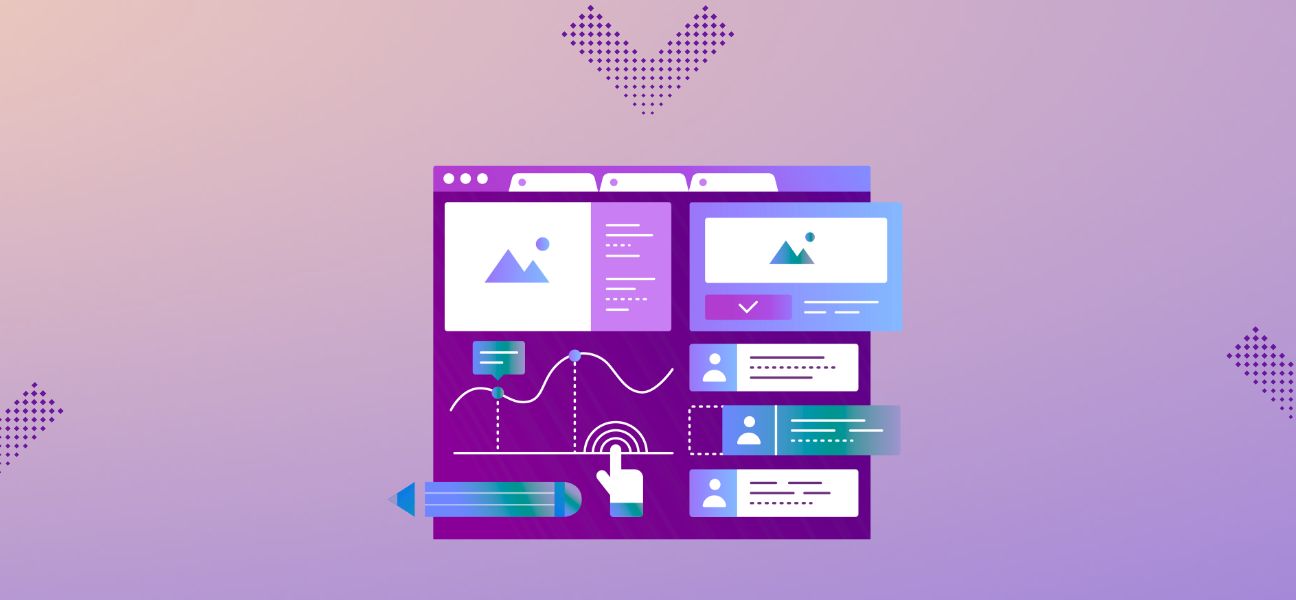
Introduction
For sales and proposal teams, responding to Requests for Proposals (RFPs) can quickly become overwhelming. Each new request demands a fresh document, yet much of the content repeats from past submissions. Without a structured template, teams waste hours reformatting, chasing inputs, and rewriting the same sections.
Research shows that proposal teams spend nearly 25% of their time each month on RFP responses, often pulling input from multiple stakeholders across sales, solutions, and finance teams (APMP). That inefficiency translates into slower deal cycles, higher costs, and missed opportunities.
In this guide, we'll explore what an RFP response template is, the key components you need, and how automation can take templates to the next level.
TL;DR
- RFP response templates save time by standardizing structure, reducing rework, and preventing costly errors.
- Custom templates improve consistency and collaboration, making it easier for sales, finance, and legal teams to contribute effectively.
- Vendors using structured templates see up to 10–15% higher win rates, thanks to polished, accurate, and timely submissions.
- Inventive AI transforms static templates into intelligent tools, auto-drafting responses up to 90% faster while ensuring 95% accuracy.
- Teams complete 3x more RFPs with the same staff, cutting cycle times and boosting revenue without adding headcount.
Why Custom RFP Templates Matter?
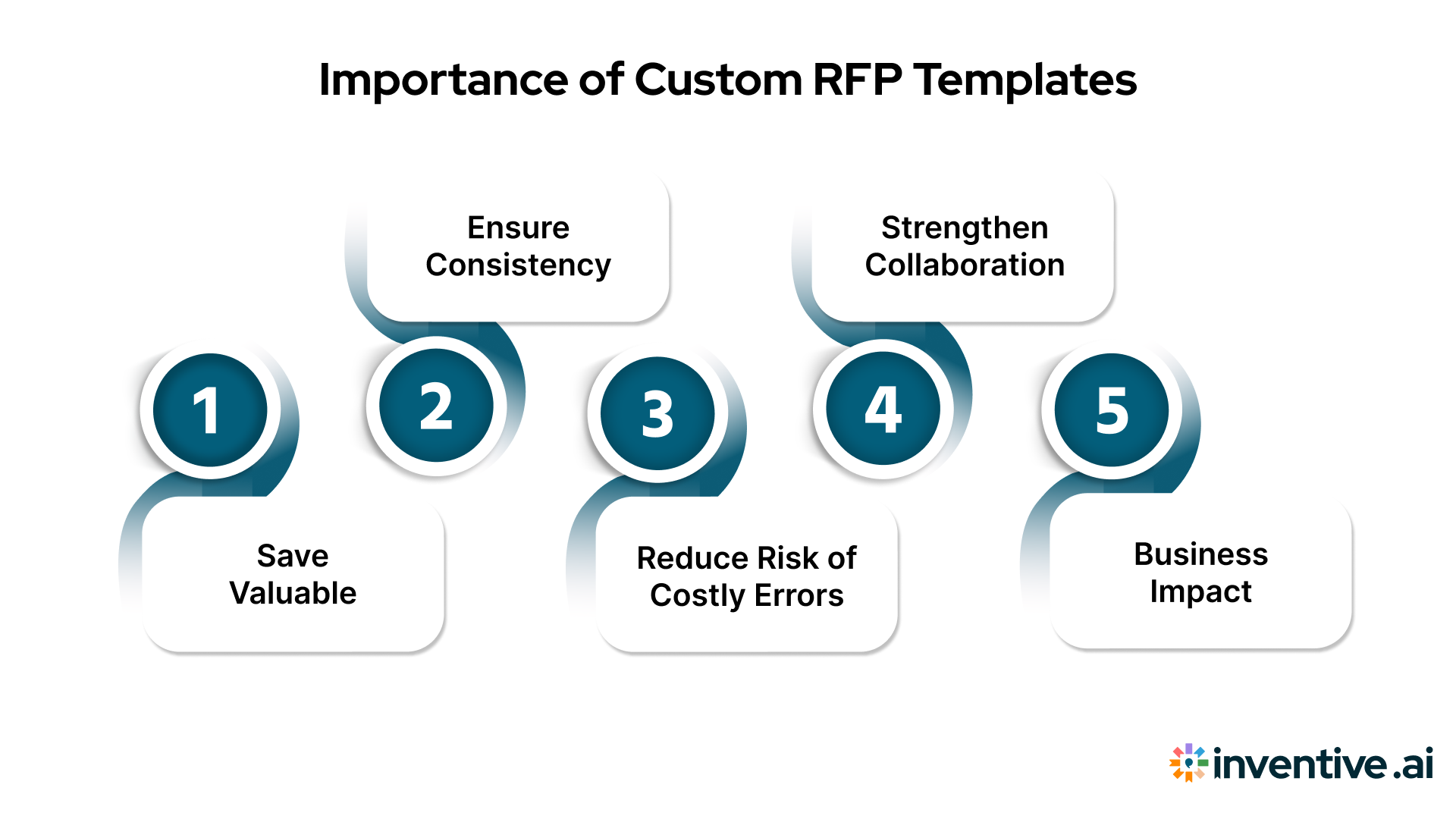
Here is why custom RFP templates are essential -
Save Valuable Time
Proposal teams often spend hours reformatting and rewriting content for every new RFP. Without a consistent structure, each response becomes a manual project that drains resources. Custom templates reduce this burden by giving teams a ready-made framework to work from, allowing them to focus on tailoring answers rather than rebuilding documents.
Ensure Consistency Across Responses
Buyers quickly notice when proposals vary in tone, structure, or quality. A custom template enforces brand standards, ensures critical details are never missed, and delivers a polished, professional impression every time.
Reduce the Risk of Costly Errors
Mistakes in RFP responses, such as outdated information or incomplete sections, can cost vendors valuable opportunities. Templates act as checklists, guiding teams to include all required details while keeping content accurate and compliant. This structure reduces oversight and increases the likelihood of passing initial evaluations.
Strengthen Team Collaboration
RFPs often require input from sales, solutions engineers, finance, and legal teams. Without a shared format, collaboration becomes messy and time-consuming. Custom templates make it easier for multiple stakeholders to contribute seamlessly by providing a centralized structure that everyone can follow.
Drive Measurable Business Impact
For CROs and VPs of Sales, the value of templates goes beyond efficiency. Faster, more consistent responses translate into shorter deal cycles and higher win rates. By providing a precise and repeatable process, templates help organizations compete more effectively in high-stakes procurement environments.
Now that the "why" is clear, the next step is defining precisely what a vendor-focused response template is, and what it is not.
What is an RFP Response Template?
An RFP response template is a pre-structured framework that vendors use to answer buyer-issued Requests for Proposals. Instead of starting every response from scratch, teams can rely on a reusable document that already includes the essential sections buyers expect. This reduces manual work, ensures accuracy, and speeds up the overall response process.
Unlike RFP templates created by buyers to issue requests, response templates are built for vendors. They act as a blueprint for crafting persuasive, compliant, and client-ready proposals. The goal is to simplify the responder's workflow while ensuring that all buyer requirements are covered in a clear, professional format.
An effective RFP response template provides a consistent structure, like an executive summary, company overview, solution details, and pricing, while leaving room for customization. This balance allows teams to maintain efficiency while still tailoring responses to each client's specific needs.
By organizing content in a repeatable way, RFP response templates help proposal managers and sales teams avoid delays, reduce errors, and deliver polished responses under tight deadlines. The result is higher-quality submissions that inspire buyer confidence and increase the chances of winning contracts.
With the definition in place, let's break the template into the core components your team should include every time.
Key Components of a Custom RFP Response Template
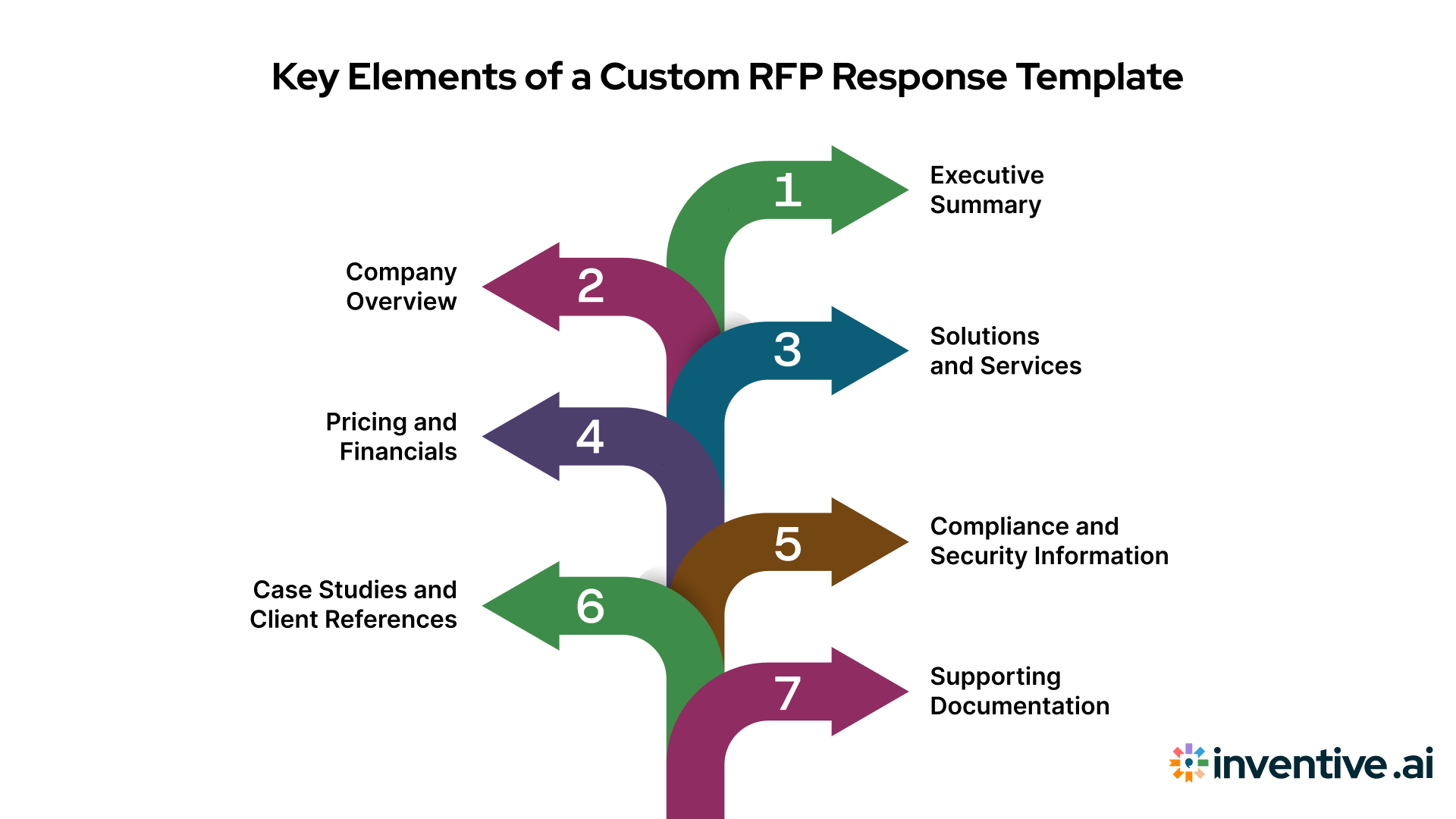
A strong RFP response template is a repeatable framework that gives proposal teams a head start on every submission. By including the right sections, vendors can reduce rework and create professional responses that resonate with buyers.
Below are the key components every template should have:
Executive Summary
The executive summary is the first section most decision-makers read, and in many cases, it shapes their perception of the entire proposal. This section should concisely reflect the client's goals while clearly outlining how your solution addresses those needs. It's your chance to make a persuasive case for why your organization is the best choice. By standardizing this section in your template, you give your team a consistent structure to build from, while still leaving flexibility for tailoring to each client's priorities.
Company Overview
This section builds trust by showing buyers who they will be partnering with. A well-prepared company overview should highlight your organization's history, mission, values, and industry expertise. Including differentiators, such as years of experience in a particular vertical or awards and recognitions, reinforces credibility. By keeping this section consistent across proposals, you ensure your brand story is constantly presented professionally, while saving time for teams who no longer need to rewrite it for each response.
Solutions and Services
The solutions and services section is the heart of any RFP response. This is where vendors align their offerings with the buyer's stated requirements. A strong template should break this section into modular subsections, making it easy to adapt technical or business details for different clients. For example, a software provider might have a standard description of its platform's core features, with editable areas to insert details about custom integrations or deployment methods. This structure ensures consistency while allowing space for tailored, client-specific messaging.
Pricing and Financials
Pricing is one of the most scrutinized parts of any proposal. A response template should provide a clear framework for presenting costs, whether in the form of tiered options, service bundles, or line-item breakdowns. Standardized tables and layouts make financials easier for buyers to evaluate and reduce errors when internal teams update figures. For sales leaders, this consistency helps avoid miscommunication, ensuring that the financial proposal always aligns with the organization's commercial strategy.
Compliance and Security Information
In regulated industries, compliance is a key factor that often determines whether a vendor moves forward in the evaluation process. A good template should include a dedicated section for compliance certifications, security standards, and data privacy practices. Keeping this information organized ensures buyers see that your company meets critical requirements without the need for lengthy back-and-forth. Since certifications and security practices change over time, this section should be regularly updated in your knowledge hub to prevent outdated information from slipping through.
Case Studies and Client References
Buyers want reassurance that your company can deliver on its promises. Case studies and references provide that proof. A template should allocate space for client success stories, structured in a way that highlights the challenge, your solution, and the measurable outcomes. Including testimonials or reference contacts further reinforces credibility. By standardizing the format, teams can swap in the most relevant examples quickly, helping each proposal feel tailored without requiring additional design or formatting effort.
Appendices and Supporting Documentation
While not every evaluator will read the appendices, having them in place demonstrates thoroughness and professionalism. This section can hold product brochures, technical diagrams, legal agreements, or implementation timelines that support the main proposal. By organizing this content in a consistent format, teams make it easier for buyers to find additional details when needed, while keeping the core proposal focused and digestible.
Knowing the components is useful; anticipating buyer requests is even better. Here's how to address the standard sections that show up in most RFPs.
Standard RFP Sections and How to Address Them?
Most buyer-issued RFPs follow a predictable structure. For vendors, anticipating these sections and preparing template-based responses ensures faster turnaround and more accurate answers.
Below are the standard sections you'll see in an RFP, and how your team can address them effectively.
Company Background and Qualifications
Buyers often begin by asking vendors to introduce themselves. This section usually requests details about your history, size, industry experience, and client portfolio. Vendors should respond with a concise, professional company overview that emphasizes credibility and relevance to the buyer's sector. Having this content pre-formatted in a response template ensures that every proposal presents a consistent brand story while leaving room for client-specific highlights.
Product or Service Description
Almost every RFP includes a section where vendors must describe their offerings in detail. The goal is to show alignment between what you provide and what the buyer needs. Vendors should avoid generic descriptions and instead use the template to highlight core features alongside measurable benefits. This section should also include space for customization so teams can tailor technical specifications, integrations, or workflows for each client without reformatting the entire proposal.
Pricing and Payment Terms
Cost transparency is a critical evaluation factor for buyers. This section typically asks for itemized pricing, tiered packages, or subscription details, depending on the nature of the service. Vendors should address this by using pre-built tables within their templates that allow quick updates to numbers while maintaining consistency in structure. Clear, professional presentation of pricing reduces confusion and demonstrates transparency, which builds buyer trust.
Implementation Plan and Timeline
Many RFPs require vendors to outline how and when the solution will be delivered. This section should cover phases such as onboarding, training, deployment, and ongoing support. Vendors can prepare a standardized timeline framework within their templates, ensuring that teams only need to adjust specific dates and milestones per client. This prevents delays in drafting and assures buyers that you have a well-structured process in place.
Compliance and Security Requirements
Buyers in regulated industries almost always include a section on compliance and security. Vendors must show evidence of certifications, adherence to regulations, and data security measures. By keeping an updated compliance section within the response template, teams avoid scrambling for documents at the last minute. This not only reduces errors but also communicates that your company takes regulatory obligations seriously.
References and Case Studies
RFPs often close with a request for client references or proof of past success. Vendors should be prepared with pre-formatted case studies that highlight client challenges, the solutions provided, and quantifiable results. A well-organized template makes it easy to insert relevant examples quickly. Tailoring the references to match the buyer's industry or scale adds extra credibility and strengthens the response.
Once you know what to cover, it's time to build the framework. The following section walks through a practical, step-by-step process to create your template.
How to Create an Effective RFP Response Template?
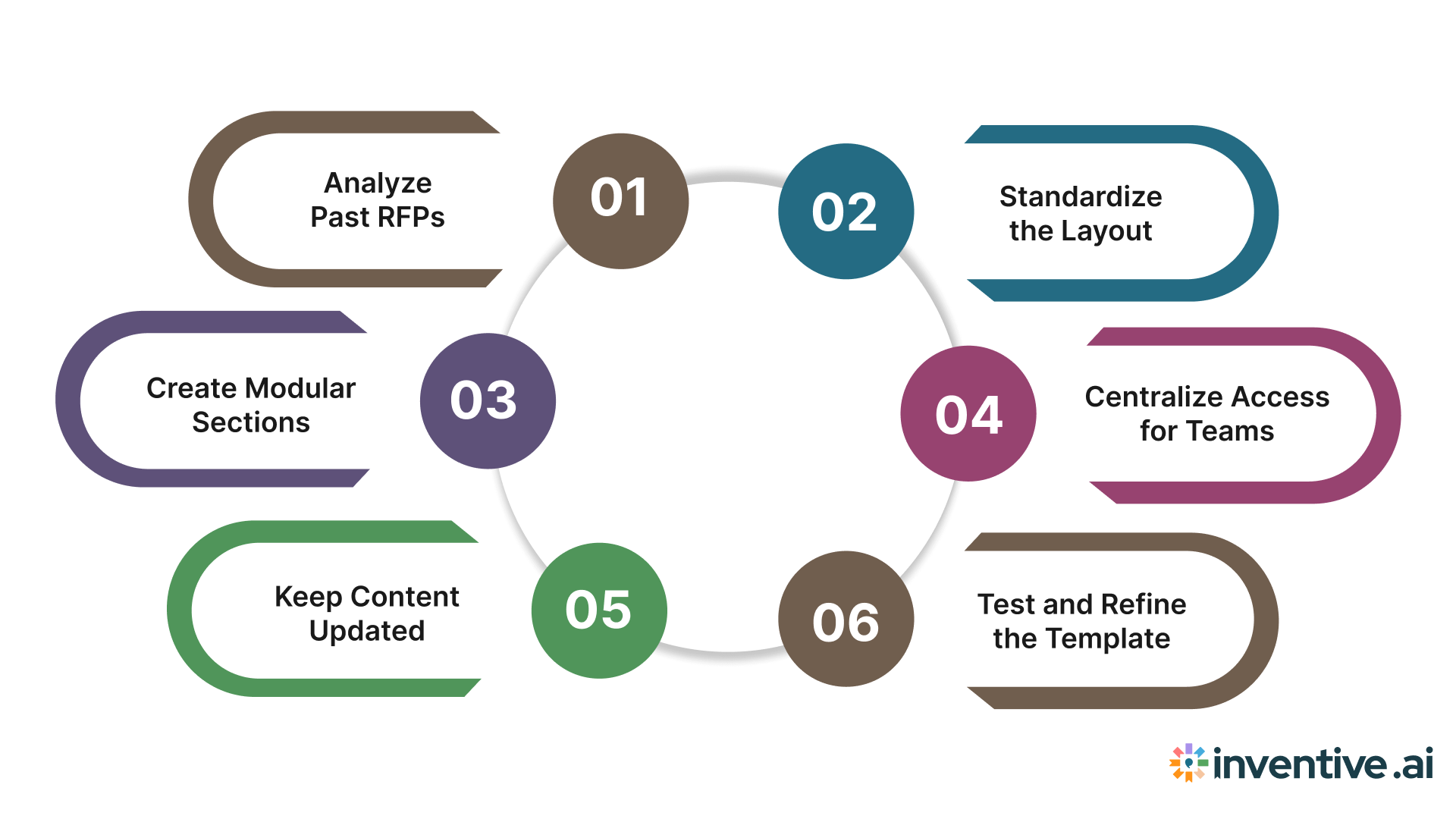
Building a custom RFP response template requires more than just formatting a document. The goal is to design a framework that is efficient, adaptable, and easy for multiple teams to use. Here are the essential steps:
Step 1: Analyze Past RFPs
Start by reviewing your organization's past RFP responses. Identify the sections that appear most frequently, like executive summaries, company overviews, pricing tables, and compliance details. This analysis ensures your template covers recurring buyer requirements and reduces the need to reinvent content with every new proposal.
Step 2: Standardize the Layout
A clear, consistent structure helps teams work faster and makes responses easier for buyers to evaluate. Standardize font styles, section headers, tables, and formatting rules across the template. This eliminates time wasted on formatting and ensures your proposals always look professional and aligned with your brand.
Step 3: Create Modular Sections
Not all RFPs are the same, so your template should be modular. Break it into self-contained sections, such as executive summary, solution details, pricing, and compliance, that can be reused or swapped depending on the client's needs. This flexibility allows proposal managers to adapt quickly without disrupting the overall structure.
Step 4: Centralize Access for Teams
Since RFP responses involve input from multiple departments, your template should be stored in a central location accessible to sales, finance, solutions, and legal teams. This prevents version-control issues and ensures everyone is working from the same framework. A shared repository also makes collaboration smoother, especially under tight deadlines.
Step 5: Keep Content Updated
Outdated information, such as expired certifications, old case studies, or irrelevant references, can damage credibility and even disqualify a vendor. Establish a process for regularly updating your template, ensuring that content remains fresh and aligned with your current offerings. Assign ownership for each section so accountability is clear.
Step 6: Test and Refine the Template
Once created, put your template to use in real RFP responses and gather feedback from proposal managers and contributors. Identify where the structure works well and where it causes friction. Refine the template based on this feedback so it continues to improve over time and delivers measurable efficiency gains.
By following these steps, vendors create an RFP response template that not only speeds up the drafting process but also raises the overall quality and competitiveness of their proposals.
A solid template is only effective when teams use it well. Apply these best practices to maximize consistency, speed, and quality.
Common Mistakes to Avoid When Creating Your RFP Template
Even the most well-structured RFP can fail to attract the right vendors if common mistakes creep in.
Here are key pitfalls to watch out for:
- Using Vague or Unclear Requirements
- When scope and deliverables are not clearly defined, vendors submit mismatched proposals, leading to wasted time and poor evaluations.
- Overloading with Irrelevant Questions
- Adding every possible question makes the RFP long and inefficient. Focus only on details that directly impact vendor evaluation.
- Ignoring Internal Stakeholder Input
- If finance, IT, or operations teams are not consulted, the RFP may overlook crucial needs, causing delays and rework later.
- Failing to Prioritize Evaluation Criteria
- Without clear weighting (e.g., price vs. innovation vs. support), selection becomes subjective and prone to bias.
- Neglecting Long-Term Value
- Choosing vendors purely on cost can backfire. Overlooking factors like scalability, ESG practices, or innovation often results in higher long-term risks.
By avoiding these mistakes, teams can build RFP templates that attract quality vendors, streamline evaluations, and lead to better business outcomes.
Establishing a Template Governance Framework
An often-overlooked mistake is failing to manage RFP templates as living documents. To keep them effective, organizations should establish a clear governance framework:
- Defined Roles: Assign an owner (responsible for maintaining the template), an approver (ensuring alignment with business goals), and contributors (subject matter experts who provide updates).
- Scheduled Reviews: Conduct quarterly reviews to verify that the template reflects current requirements, compliance standards, and industry practices.
- Update Triggers: Implement rules to update the template whenever there are new regulations, product changes, or process shifts that impact vendor requirements.
By embedding governance into the template process, organizations can prevent outdated content, ensure accuracy, and make RFPs more effective over the long term.
Best Practices for Maximizing Template Use
Even the best-designed RFP response template delivers value only when it is used correctly. To ensure your team gets the most from templates, consider these best practices:
Keep Content Fresh and Accurate
Templates lose value if they contain outdated details such as old certifications, expired client references, or retired product features. Schedule regular reviews to update content and assign ownership to ensure accuracy. This not only prevents mistakes but also reinforces buyer confidence that your organization is current and reliable.
Balance Standardization with Personalization
A template provides structure, but buyers still expect responses tailored to their needs. Encourage teams to use the template as a foundation while customizing the executive summary, solution details, and case studies for each client. Striking this balance ensures efficiency without sacrificing relevance.
Involve All Key Stakeholders Early
Since RFP responses often require input from sales, finance, technical, and legal teams, collaboration is essential. By centralizing the template in a shared workspace, stakeholders can contribute more efficiently and avoid last-minute delays. This practice also ensures that every section reflects the latest expertise across the organization.
Use Templates as Training Tools
For new team members, templates act as an educational resource. They provide examples of tone, structure, and the type of information that buyers expect. Embedding guidance notes or examples within the template helps onboard new contributors faster and ensures consistency across proposals.
Measure the Impact of Template Use
To prove the business value of templates, track key metrics such as response time reduction, proposal quality scores, and win rates. Sharing these results with leadership helps demonstrate how structured processes translate into revenue impact, while also building support for future improvements in the RFP workflow.
Strong execution should translate into measurable gains. Here's how custom templates impact turnaround time, collaboration, quality, and win rates.
Benefits of Using Custom Templates in RFP Responses
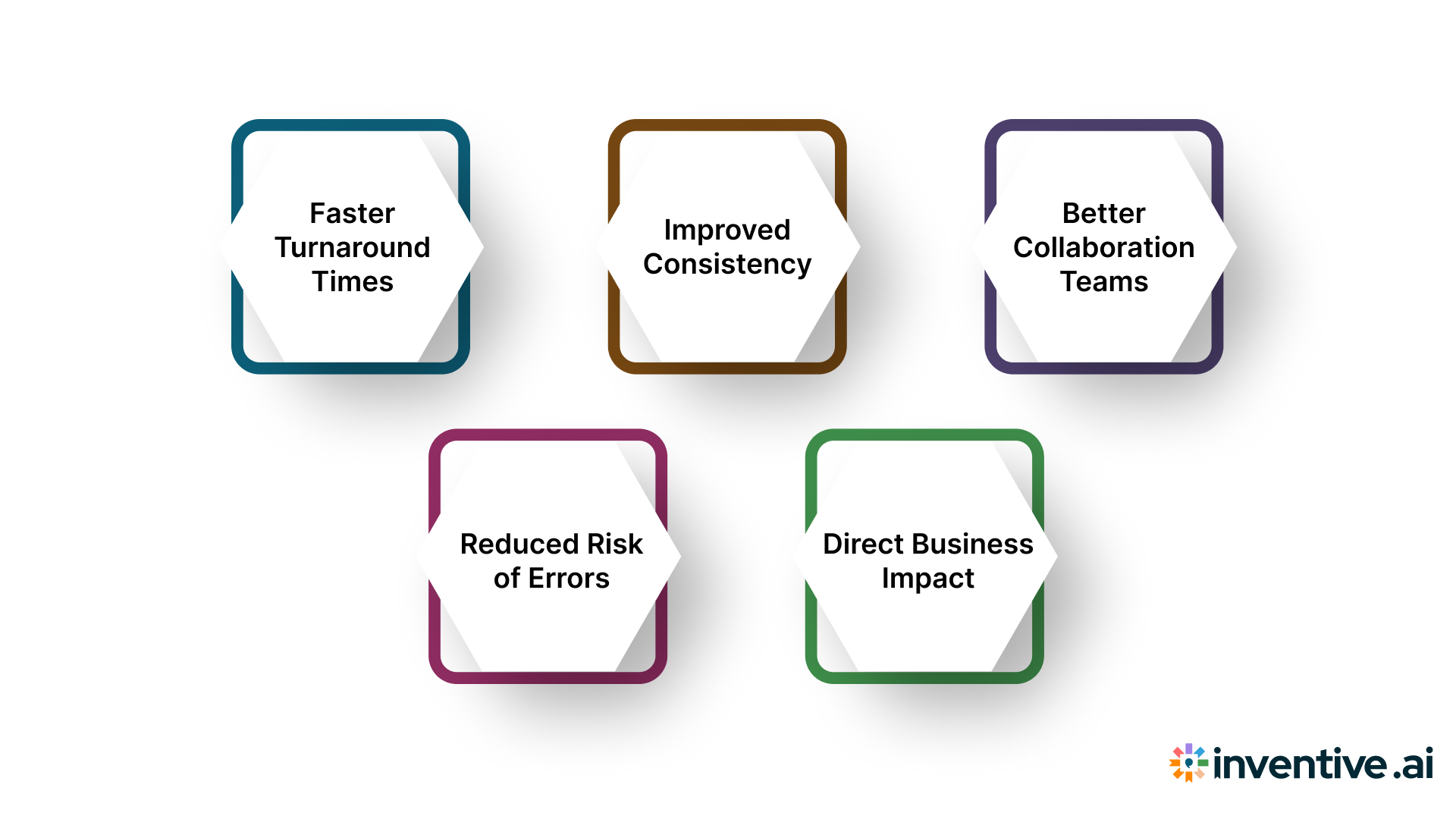
Custom RFP response templates deliver more than just time savings. They create a measurable impact across efficiency, consistency, and winning outcomes. For sales leaders and proposal managers, these benefits directly translate into stronger pipelines and faster deal cycles.
Faster Turnaround Times
With a pre-structured template, teams no longer waste hours formatting documents or reusing outdated responses. Instead, they can focus on tailoring content to the client's needs. Research shows that organizations using structured RFP processes reduce response times by 30–40% on average, giving sales teams the ability to respond to more opportunities within the same time frame.
Improved Consistency and Quality
Consistency is often the difference between a proposal that makes it to the shortlist and one that gets discarded. Templates ensure that every submission follows a professional, organized format with no missing sections. According to APMP benchmarks, nearly 72% of organizations struggle with inconsistent responses, which can undermine buyer confidence. Custom templates help close this gap by standardizing the structure while still allowing for client-specific personalization.
Better Collaboration Across Teams
RFPs typically require input from multiple stakeholders, like sales, finance, solutions engineers, and legal teams. A central template provides a shared framework, reducing miscommunication and version-control issues. This streamlines collaboration and helps teams meet tight deadlines without sacrificing proposal quality.
Reduced Risk of Errors
Errors in pricing, compliance details, or client references can cost deals and damage credibility. Templates act as a built-in checklist, ensuring that critical sections are always included and updated. This reduces the risk of oversight and helps maintain a higher win rate.
Direct Business Impact on Win Rates
Ultimately, templates increase competitiveness. By improving efficiency and consistency, sales teams can respond to more RFPs, deliver higher-quality proposals, and accelerate deal velocity. Industry research suggests that organizations using structured RFP processes see up to a 10–15% improvement in win rates, giving them a clear revenue advantage over competitors.
To help you put this into action immediately, download the ready-to-use RFP response template and adapt it to your following proposal.
Download Free RFP Response Template (PDF)
Creating every RFP response from scratch slows down your team and increases the risk of errors. To help you accelerate the process, we've prepared a free, customizable RFP response template designed specifically for vendors.
This template includes:
- A cover page for the client and submission details.
- Pre-structured sections for executive summary, company overview, solution details, pricing, and case studies.
- Ready-to-use tables for requirements mapping, implementation timelines, pricing, and SLAs.
- Dedicated placeholders for assumptions, dependencies, and appendices.
- Clear instructions so your proposal team can adapt and personalize quickly.
Use this template to save time, improve consistency, and deliver higher-quality proposals that increase your win rate.
Download the Free Custom RFP Response Template (PDF)
How AI RFP Automation Adds Value?
While custom templates provide structure and efficiency, they still rely heavily on manual updates and human oversight. Teams may save time, but they continue to face challenges like outdated content, repetitive edits, and version-control issues. This is where AI-driven automation takes templates to the next level by transforming them from static documents into dynamic, intelligent tools.
Automates First Drafts at Scale
Instead of manually filling in templates, AI RFP automation can generate complete first drafts based on historical responses and current knowledge bases. This allows proposal teams to focus on refining and tailoring responses, rather than starting from scratch. Vendors adopting AI solutions often cut drafting time by up to 90%, dramatically increasing throughput.
Ensures Content Freshness and Accuracy
One of the most significant risks with templates is outdated content, such as old case studies, expired certifications, or inconsistent product details. AI tools proactively flag stale information and pull updated data from centralized knowledge hubs. This ensures that every proposal reflects the most current and accurate information, reducing costly errors.
Improves Consistency Across Responses
While templates create a consistent format, AI ensures consistency in tone, messaging, and technical accuracy across multiple proposals. This alignment strengthens the overall quality of responses, giving buyers greater confidence in the vendor's reliability.
Boosts Team Productivity
Manual template use still requires significant coordination between sales, finance, and solutions teams. AI RFP automation integrates with collaboration platforms like Slack or Microsoft Teams, streamlining workflows and reducing friction between departments. This frees teams to focus on strategy and client engagement rather than document management.
By combining the structure of custom templates with the intelligence of AI automation, vendors unlock the best of both worlds: faster, smarter, and more persuasive RFP responses that directly support revenue growth.
If you want these AI advantages in a single workflow, here's how Inventive AI layers automation, content freshness, and consistency on top of your templates.
How Inventive AI Improves RFP Templates?
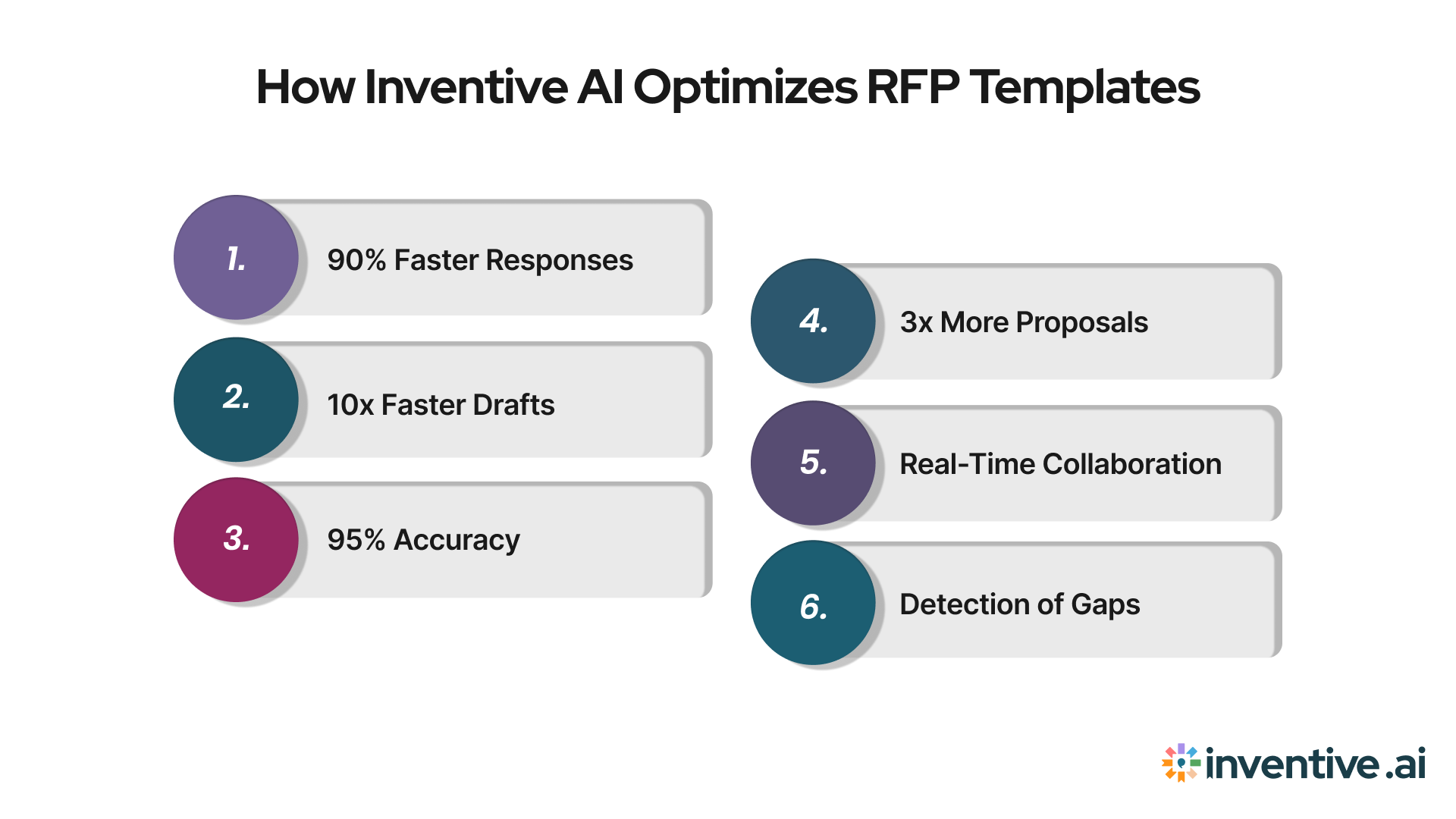
Custom templates provide structure, but on their own, they remain static documents that require constant updates and manual oversight. Inventive AI turns those templates into intelligent, living tools that accelerate speed, improve accuracy, and raise win rates.
90% Faster Template-Driven Responses
Instead of manually filling in sections, Inventive AI auto-generates first drafts directly into your response templates. Teams cut drafting time from 20+ hours down to just 2–3 hours, freeing up resources to refine messaging and focus on strategy.
10x Faster Drafts From a Central Knowledge Hub
All template sections, i.e, executive summaries, and pricing tables, are pulled from Inventive AI’s centralized knowledge hub. No more digging through outdated files or chasing SMEs. Every draft uses verified, pre-approved content.
95% Accuracy With Fresh, Verified Content
Inventive AI’s Content Manager automatically flags expired certifications, conflicting figures, or stale product details before they slip into your proposals. With confidence-scored responses, reviewers know where to focus, reducing errors and building buyer trust.
3x More Proposals Completed Without Extra Headcount
Proposal teams using Inventive AI report handling up to three times more submissions with the same staff. Templates combined with automation ensure more RFQs and RFPs are completed without overloading teams or missing deadlines.
Real-Time Collaboration Across Stakeholders
Integrated with Slack and Microsoft Teams, Inventive AI keeps finance, legal, sales, and solutions aligned. Contributors can update sections, approve changes, and finalize content in real time, directly within the template framework.
Automatic Detection of Gaps and Inconsistencies
Inventive AI proactively highlights missing data, outdated numbers, or inconsistent messaging within templates. This ensures every proposal is polished, compliant, and client-ready.
Here’s why it matters for sales and proposal teams:
- Cut template-driven response times by 90%.
- Eliminate outdated or conflicting content before submission.
- Collaborate seamlessly across departments.
- Improve proposal accuracy with confidence-scored drafts.
- Respond to 3x more RFPs without increasing headcount.
Conclusion
Custom RFP response templates give vendors a powerful head start. Such a guide can save time, enforce consistency, and reduce the risk of errors, all of this while making it easier for teams to collaborate under tight deadlines. For sales leaders and proposal managers, the business case is clear: structured templates improve efficiency and raise the quality of every submission.
Yet templates alone have their limits. They still depend on manual updates, repetitive edits, and constant oversight to remain effective. That's where automation makes the difference.
If your team is ready to move beyond static templates and achieve measurable impact, it's time to explore automation.
FAQs
1. What is the difference between an RFP template and an RFP response template?
Buyers create an RFP template to request information from vendors, while an RFP response template is designed for vendors to reply efficiently. This blog focuses on response templates, which help sales and proposal teams deliver faster, more consistent answers.
2. How often should RFP response templates be updated?
Templates should be reviewed at least quarterly to ensure details such as pricing, certifications, and case studies remain accurate. Outdated information can damage credibility and even disqualify a response. Using automation tools makes this process much easier.
3. Can AI replace templates entirely?
AI doesn't replace templates. Templates provide structure, while AI fills those templates with accurate, updated content and automates repetitive drafting tasks. Together, they deliver faster, higher-quality responses.
4. Do templates actually improve win rates?
Yes. Templates save time, reduce errors, and ensure consistent messaging, which directly improves proposal quality. Research shows that organizations using structured RFP processes see up to a 10–15% improvement in win rates compared to those without standardized templates.


